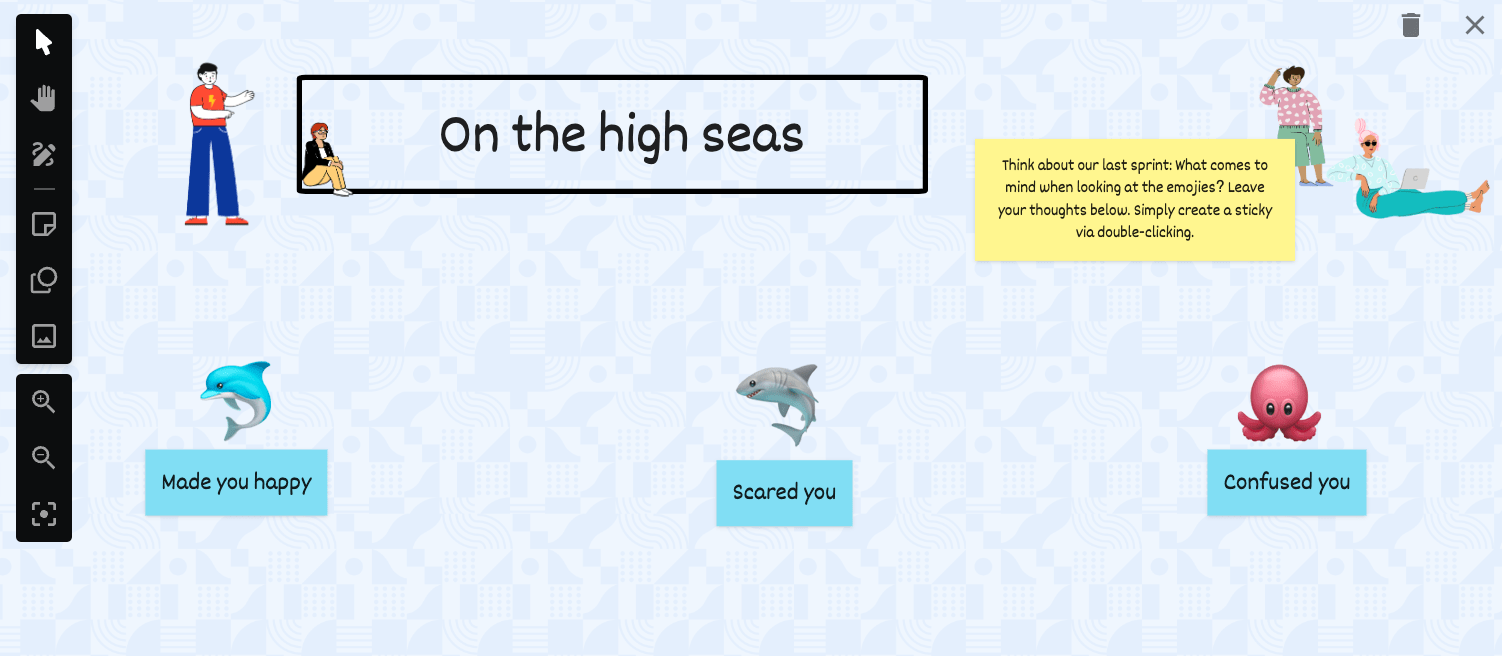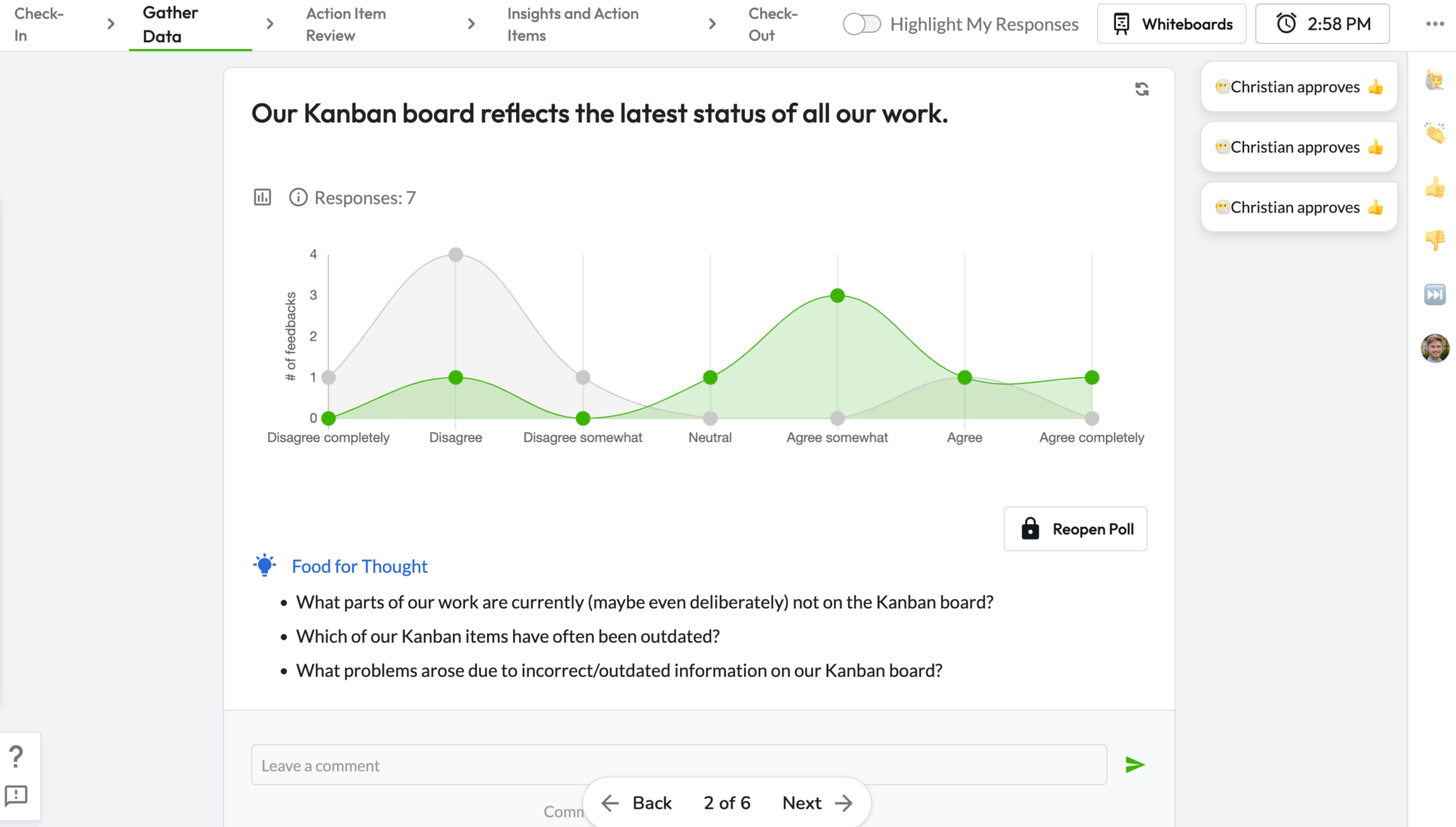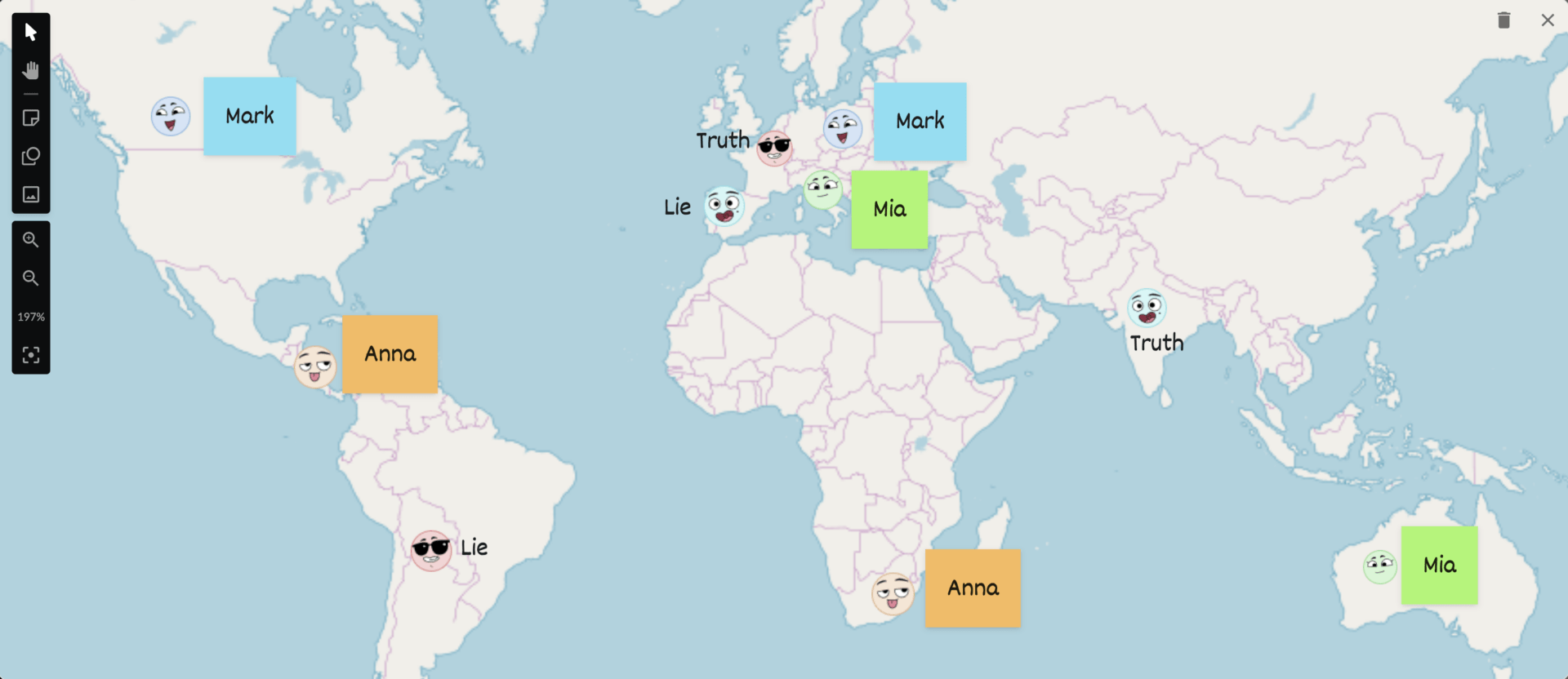Table of Contents
Are you in the mood for some fun Icebreaker games for the retrospective? Then you've come to the right place. Because we will present some fun, novel and above all effective retrospective games and ideas (See post: The 15 best retrospective games).
Before we start naming every single icebreaker game for retrospectives, here's what makes good retro games in a nutshell. Overall, good retrospective ideas have 5 characteristics from our point of view.
- Interactive: Really good retrospective games are characterized by the fact that each participant has to think or become active in order for the game to be successful. It is even better if every team member speaks at least once. This is especially true for retrospective games in the check-in of the retro (i.e., icebreaker), because the rule of thumb says: If you don't say anything in the check-in aka icebreaker, you won't say anything in the entire retro.
- Teamwork: Good Icebreaker games for retrospective strengthen the team spirit. Two simple mechanisms can help – especially in the Check-In, the Icebreaker of the retro: Either they help team members get to know each other better (privately) and thus indirectly strengthen psychological safety in the team (see article: Psychological Safety in Agile Teams). Or the retrospective games and ideas let the team collectively overcome a small challenge – which also fosters team spirit.
- Positive: In the everyday life of an agile team, there are often enough occasions for stress. For this very reason, the retrospective as a protected space should consciously break out of this pattern. It should basically have the goal of creating a positive mood among team members. This can be achieved, for example, with an icebreaker or a check-in and check-out that puts a smile on team members' faces. Of course, this does not mean that critical topics should not be addressed; on the contrary, only if successful action items are developed can the good mood be sustainable (See post: 8 Tips for Successful Action Items in Retros).
- Adequate: Retrospective Icebreaker games and ideas should be adapted to the maturity level and the current mood of the team. For example, the particularly creative or metaphorical games are more suitable for teams that have already completed many retros (i.e., tend to have a higher maturity level; see also post: 7 tips when the team doesn't want to do retros anymore). In addition, a retrospective game, in which the aim sometimes is to make team members laugh, is of course a bad fit if something negative is currently depressing the mood, such as layoffs.
- Transition (Optional): Whether the retrospective game is used at the beginning, middle, or end of the retro: It is more professional if it has a concrete reference to the step before and/or after. For example, check-ins or icebreakers are often suitable to get a first feeling for the last agile Scrum Sprint before going into a deeper reflection.
Of course, these features are not mandatory. But they help to select the right retrospective check-ins or icebreakers. By the way, you can find more detailed thoughts on the most important 5 outcomes of a retrospective here: 5 Outcome vs. Output Examples of a Retrospective. Well, that's enough. The headline promised it to you – here are the 4 Icebreaker games for retrospectives:
- The Last Sprint as a Kitten
- Attention: Bad Jokes
- Team Health Check Radar
- Born to lie
Fresh Retrospective Icebreaker Games & Ideas
Icebreaker games for retrospective
Icebreaker Game 1: The last sprint as a kitten 😻
Retro game on the online whiteboard
Duration: 5-15 minutes | Goal: Fun, Icebreaker, Reflection of the Scrum Sprint
Idea: This is a classic retrospective warm up game for the check-in: The goal is to capture the mood regarding the last sprint. The best way to do that is through pictures. In this case, the question is which cute face of a kitten best sums up the last sprint.
- As a facilitator, you explain the rules to each team member: In front of you on the Echometer whiteboard are some pictures of kittens. Based on your gut, which one fits best with the last sprint? The reasons why you choose a picture are rather unimportant.
- Everyone decides on a picture by creating a sticky on the whiteboard (double clicking on it).
- Now everyone explains briefly in one or two sentences why they have chosen the respective kitten. The decision may deliberately not be completely "logical" – it is first only to capture the emotional situation and create a good atmosphere for conversation.
- The respective check-in of the team members is neither evaluated nor commented. At most, something interesting is written down to be used again in the later part of the retrospective.
- Now you are moving on to the next phase of the retrospective, "Data Gathering" (To the post: 5 phases of a retro are not enough). Alternatively, you can (for example in the Echometer tool) also review the action items of the last retrospective.
Icebreaker games for retrospective
Icebreaker Game 2: Attention, bad jokes 😉
Retro game on the online whiteboard
Duration: 10-20 minutes | Goal: Getting to know each other, team spirit, icebreaker
Idea: This game also serves especially as an icebreaker, with which you can create a good conversational atmosphere or a few laughs. The basic idea is that (more or less good) jokes are read out. The one who laughs first has lost.
You can see the basic idea of this retrospective game well on the online whiteboard above.
- In each of the gray boxes there is a joke hidden. If you click on the button below (visible on the Echometer whiteboard when you hover over it with your mouse), the joke will be visible to the team members that are online. Now read out the first joke.
Of course, you can deliberately read the joke in an entertaining or dry way, depending on your own style. - During or after the joke is read out, no one on the team is allowed to smile (let alone laugh out loud). Accordingly, everyone should also turn on their camera to identify possible losers.
- Next, either the facilitator can read out the next joke. Or, and I would recommend this, one of the team members reads out the next joke after it has been revealed by the retrospective facilitator. This way, everyone participates, and the likelihood of a laugh is even higher.
- You can point out that team members are allowed to read the joke before they read it aloud (even if other team members have already seen it).
- If you like, you can count who laughs the most or least often and distribute points based on that. To do this, you can simply create a circle as "One point" on the Echometer whiteboard.
The following jokes only work in English. However, googling "bad jokes" can very quickly find jokes in other languages.
What did the fish say when he swam into a wall? Dam.
What do you call a fish with no eyes? A fsh.
What kind of shorts do clouds wear? Thunderwear
There are three types of people in the world: Those who can count and those who can't.
Did you hear about the Italian chef who died? He pasta-way.
What is Forrest Gump's email password? 1forrest1. (Run Forrest, Run)
Did you hear about the guy who invented the knock-knock joke? He won the "no-bell" prize.
What is Forrest Gump's email password? 1forrest1. (Run Forrest, Run)
Two windmills are standing on a wind farm. One asks, "What's your favorite type of music?" The other says, "I'm a big metal fan."
I like elephants. Everything else is irrelephant
What's red and bad for your teeth? A brick.
What do you call a fake noodle? An impasta.
Did you hear the story about the claustrophobic astronaut? He just needed some space.
What do you call an alligator in a vest? An in-vest-igator.
What kind of tea is hard to swallow? Reality.
A man and a giraffe walk into a bar. After a few drinks, the giraffe falls over and dies. The man begins to walk out when the bartender stops him. "Hey, you can't leave that lyin' there!" The bartender yells out. The man turns around: "It's not a lion. It's a giraffe."
Icebreaker games for retrospective
Game 3: On the high seas 🐟
Retro game on the online whiteboard
Duration: 30-90 minutes | Goal: Reflection of the last Scrum Sprint, data collection
Idea: This is a so-called Emoji Retro: Based on the emojies and the questions mentioned beside them, each team member reflects on the last sprint on the online whiteboard. In this case, we are on the high seas. Various sea creatures that we see trigger different associations in us.
- As a facilitator, you explain the rules to the team: Based on the emojis and the corresponding questions, each team member reflects on the last Scrum Sprint.
- Dolphin: What made you happy?
- Shark: What scared you?
- Squid: What confused you?
- The feedback is first collected individually and anonymously on the whiteboard (for example in Echometer). You can use the timer and set it to 3 minutes, so that this part does not take too long. By the way: In Echometer this part, the "data gathering" can even be done asynchronously before the retro in the form of a digital survey.
- In the next step, each team member presents the results individually and the further phases of the retrospective are continued: Topics are discussed, prioritized with the help of a voting and action items are derived (To the post: 5 phases of a retrospective). The Echometer Retro Tool can help you with all this.
Recommendations from our Retro Tool Idea collection
Within our agile retrospective and health check tool Echometer we have very many Icebreaker games for retrospectives (See website: Comparing the 6 best retrospective tools).
That's why we've added 3 more retrospective warm-up games and ideas that go in a slightly different direction. For example, our Team Health Check or the classic and simple "Mad, Sad, Glad" retrospective format. Have fun trying them out!
Icebreaker game for retrospective
Icebreaker Game 4: The Team Health Check 📈
12. Retro game on whiteboard (Scrum Retro Game ideas)
Duration: 45-90 minutes | Goal: Reflecting on teamwork and agile processes
Idea: Why not do a health check in your team retrospective? It can be fun, depending on the things you ask. Everyone indicates how they view a certain topic on a scale from 1 to 7!
- You choose a number of sentences, of behaviors that you think the team could improve on in the Echometer tool. E.g., these are the things that are asked in the Spotify health check.
- Of course, you can change these questions, making some of them more fun or creative.
- Everyone indicates how much they agree to these statements on the Echometer scale from 1 to 7.
- The results are shown in the graph. Now, everyone is invited to explain the results:
“From your personal perspective, wow do you explain the highest voting? And the lowest voting?” - Once you went through all the health check items and discussed them, you proceed with the typical 5 phases of an agile retrospective.
- Explaining feedback: After everyone is done with this part, everyone shares their thoughts (and notes) to get a shared understanding. At this point, there is no discussion.
- Prioritization: Every team member has 3 digital dots to vote. Put your dots where you think you have room for improvement.
- Discussion: Discuss the areas that have the most votes. Do you want to put down an action item?
- Action items: Name a specific person who is responsible for that action item. Don´t put down more than 3 action items - focus on quality instead of quantity (more on this in our post 7 tips for great action items).
- We deliver great results! We are proud of it and our stakeholders are very satisfied.
- Our way of working suits us perfectly.
- We get things done really fast. No waiting, no delays.
- The planning of our sprints is always based on achieving the greatest possible customer benefit in the given time.
We also share unfinished work with stakeholders early on to get feedback as soon as possible.
- Each member of the development team contributes appropriately to the sprint planning.
- We are open to constructive feedback and can grow from it.
- Courage: We value people showing courage.
- Respect: We value each other’s ideas, even when disagreeing.
- Commitment: Every team member is committed to follow through on what they have promised.
- Focus: We don’t allow ourselves to be distracted from reaching the sprint goal.
- Openness: We are open to constructive feedback and grow from it.
- We have a constructive exchange of knowledge between newer and more experienced colleagues.
Retrospective Icebreaker Game
Icebreaker Game 5: Born to Lie 🙂
1. Retro game on online whiteboard
Duration: 10-20 minutes | Aim: Getting to know each other, analyzing team communication, retrospective games for new teams
Idea: Everyone in the team marks two places on a map - and explains why they were born there. In one of them, they were really born. The other place is a lie.
- Every team member on their own marks the place where they have been born and one additional place (possible on a digital whiteboard).
- Timebox 5 minutes: Next, they have to come up with an explanation for both places why they have been born there.
For example, this is what Julia Rodriguez would say:
A) As you all know, I have been born right around the corner in New York, I mean, this is why I work here and why I am visiting my family every weekend.
B) As you all know, my family name is Rodriguez. I am actually from Mexico City, where I was born 39 years ago. My family moved to the US shortly after my birthday, because my Dad started working here.
Both make sense – what's correct? - Timebox 1 minute per person: The explanation for both places is shared one by one. After one person shared their truth and a lie, everyone in the team guesses which place is the true place of birth.
- In the end, you can delete the “lies” from the map - and you should have a nice map of where the team is from that you might even want to add to your mutual team page.
Retrospective Warm Up Game
Remote Retrospective Game 6: Mad Sad Glad Retro 😡
The "Mad Sad Glad" retrospective format is one of the classic retrospective question templates. It mentions three emotions that help to analyze the last sprint. This retrospective idea does not take place on an Echometer whiteboard, but on an Echometer Retro Board with 3 columns (see post: 6 Retrospective boards in comparison).
- What made you mad? 😤
- What made you sad? 😢
- What made you glad? 🤩
So, that's it for the presentation of the 4 Icebreaker games for the retrospective. But is that all? No, it isn't.
Retrospective ideas, icebreakers & games in our blog.
As mentioned, we have many more retrospective warm-up games and ideas both on our website and within our Echometer tool.
If you're particularly interested in Retrospective icebreaker games, you should definitely check out our post with the 15 best games (See article: The 15 best Retrospective games).
It is the right questions that are crucial for the quality of a retrospective. That's why we've created another detailed post with classic, new and creative retrospective questions. These focus especially on the second phase of the retrospective, "Data Gathering", not on the check-in or the icebreaker or the check-out (To the post: 54 fun retrospective ideas for beginners & professionals).
Last but not least, I would like to point out that you can usually find the mentioned Retrospective icebreaker games in our Retrospective and Health Check Tool Echometer. Some of them are listed as whiteboard templates, others as retrospective boards (i.e. a retrospective board is used). You can access our tool right here without logging in:
Sailboat Retro
Example: Let's imagine we are a sailboat. Tailwind: What drives us forward?
Mario Kart Retro
Example: Which bananas did we slip on?
Good vs. Bad Retro
Example: What are 3 recent things that went particularly well?
Discover More Retro Ideas
Retrospective Warm-Up Game: Conclusion
Fun in agile Scrum retrospectives and icebreakers is good and useful and hopefully this post has given you some inspiration.... But to improve Scrum Sprints process-wise sustainably, "fun" is not enough.
If I may give you, as the person responsible for your team, one more recommendation: take your time in your Sprint Retro to derive good action items (post: 8 Tips for Great Action Items in Retros). Good action items are a better remedy against "retro fatigue" than retros that are only about fun.
A good retrospective tool will not only help you have fun in agile retrospectives. It will also help you timebox well and derive the right action items. If you're still looking for such a tool, check out our post: Comparing the 7 best retrospective tools.
Most Agile Coaches and Scrum Masters run in circles...
...fixing superficial symptoms. Time to use psychology to foster sustainable mindset change.













